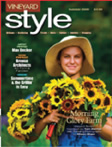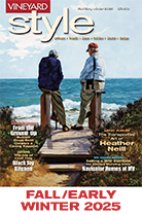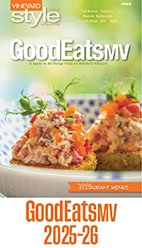CUISINE

Joyful Eating is Cooking for a Cause
Martha's Vineyard's top chefs share some of their favorite recipes for a cause
By Lisa C. Belcastro
What are you doing for fun on Island this Spring? May I suggest taking a Joyful Eatings cooking class? Not only will you learn a new recipe and a few cooking techniques from some fabulous Island chefs, but you’ll also be preparing food for Islanders in need.
For the third winter in a row, The Federated Church in Edgartown is offering free cooking classes with Island chefs. Eight “sous chefs” are invited to sign up for a class on Sundays from 2:30-4:30. All the “chefs” prepare dinner, which is then delivered to the Harbor Homes Overnight Winter Shelter for the Sunday meal.
As the shelter director, I was overwhelmed with gratitude when Jeanne Staples called me a few years back and shared her idea with me. In addition to the free cooking classes, Jeanne, an artist featured at The Granary Gallery, conceived of a cookbook.
“Pretty quickly I was thinking, the food is so good, the photos are so good, this could make a nice publication for a fundraiser for the shelter,” said Jeanne.
She envisioned every chef having a recipe in the cookbook and pictures from the cooking classes filing the pages. Jeanne’s idea back reality. The Federated Church (TFC) pays all the expenses, sells the cookbooks for $20 each, and then donates the full $20 per cookbook to Harbor Homes.
“I took a cooking class and thought, ‘this is the most awesome thing ever.’ We are helping people who need help while learning how to cook,” said TFC’s Rev. Mark Winters.
For the previous two years, I had wanted to take the class when chef Doug Smith, owner of Lucky Hank’s, was teaching. The first year I was off Island for the weekend of his class, and last year it filled up before I was able to sign up. This year, I signed up as soon as Doug’s class was posted. I was so excited. I figured Doug wasn’t going to prepare his amazing cod cakes, but I knew whatever dish he chose it would be delicious.
As luck would have it, a work scheduling conflict arose, and I wasn’t able to take Doug’s class. But I was at the shelter when he delivered the food, and I definitely sampled the chicken stroganoff, the roasted broccoli and kale, and his Christmas cookie bread pudding.
“When I think about who my client is, I choose the meal. I prepare heavier foods in winter. Stroganoff is hardy, and I love the earthiness of mushrooms,” said Doug of his choice for the shelter meal. “Personally, I’m trying to cook with less red meat, so I used chicken.”
The stroganoff was hit. Surprisingly, the roasted vegetables were an even bigger hit. People asked for seconds, not a common occurrence with vegetables, and the tray was gone by the end of dinner. “It is so easy; vegetables, salt, and olive oil,” said Doug. “You roast the kale until it releases its water and it’s crisp, but not as crisp as a kale chip. For broccoli, you still want a little bit of snap.”
I’m sorry I missed the class, but I’m grateful I was able to enjoy the food they made.
“This is the best class I’ve taught,” said Doug of his third Joyful Eatings. “The first year, I only had one recipe. This year I had recipes for everyone to take home. The first year, I had everyone doing the same thing. This year, different people had different tasks.”
Doug, who has also volunteered at the shelter and prepared dinners for the shelter, enjoys giving back to the Island community. “I really enjoyed teaching the class,” said Doug. “We had fun, but we also did it for a good cause.”
I was fortunate to take two class this winter. My first class was with Eva Faber of Goldie’s Rotisserie. Eva’s partner Lexie Roth was at home sick, so her Mom, chef Gretchen Regan, assisted.
Eva selected a pasta with Bolognese sauce and a kale salad.
“My mom made Bolognese the night before Thanksgiving. It’s Italian comfort food,” said Eva.
Eva made her first batch of Bolognese when she was nine years old. “We were planning a family dinner,” said Gretchen. “I was going to make Bolognese. I woke up with the stomach flu. I sat there in the corner of the kitchen and gave Eva instructions. She made the dinner.”
Eva split us sous chefs into groups and we each made a pot of Bolognese, minus the traditional cup of milk. The slicing and dicing went quickly, and soon the aromas in the kitchen had us all thinking about a sample.
When you make the Bolognese at home, Eva noted. two important steps, “Spread the meat out so it browns and doesn’t steam, and the wider the pot or skillet, the quicker it cooks.”
You can pour the Bolognese over any pasta you like, but Eva suggested, “Wide noodles are good. They grab a lot of sauce.” When you make the yummy kale salad, Eva told us to follow the directions. “You have to spin the kale so it doesn’t get soggy.”
Gretchen led the second class I took. Gretchen taught us how to make Kjøttboller, Norwegian-style meatballs, mashed potatoes, and cucumber salad.
I learned a lot in this class. Gretchen instructed us “to the peel the potatoes and immediately put them in cold water.” Then she talked about a potato ricer being the secret to the best mashed potatoes. I’d never heard this tip before. I ordered a potato ricer before I left the class.
The Norwegian meatballs are fun to make. It’s a hands-on busy part of the recipe. “Make the meatballs kind of small,” Gretchen instructed.
Once the meatballs were made, we rolled them in flour. We had an assembly line going, and a bit of laughter and jokes. This is definitely a fun recipe to make with friends or family.
“Cook the meatballs until they are just browned, and the flour is crispy. Then pour in the stock and simmer the meatballs in the stock until they’re cooked through,” said Gretchen.
While we used ground beef for the meatballs, Gretchen said you could use a mix of pork and beef if you wanted to.
All of us sous chefs also learned about brunost, or brown cheese, that is an essential ingredient in the sauce. “I grew up eating brown cheese,” said Gretchen. “We ate it on toast or crisp bread and used it in stews to give richness to the sauce.”
Stop & Shop sells brown cheese as Ski Queen.
The cooking classes run through early April. The third edition of Joyful Eatings will be out next summer. Every recipe in the cookbook was served to the guests at the Harbor Homes Overnight Winter Shelter. And if you take a class, there’s a good chance you’ll be in the third edition of Joyful Eatings.
You can sign up for a cooking class at this link: tfcmv.ivolunteer.com/joyful_eatings_004. There are a few of the 2024 cookbooks left.
If you’d like to order a cookbook and support Harbor Homes, visit: federatedchurchmv.org.
Bolognese Sauce Serving 8-10
Ingredients:
8 oz diced pancetta (or slab bacon, which makes it a bit smokey)
1 large onion, diced
1 large or 2 medium carrots, peeled and diced
3 Tablespoon olive oil 2 large cloves garlic, crushed or minced
2 lbs ground meat (all beef, or with veal or pork)
1/2 teaspoon ground allspice
1/2 teaspoon ground nutmeg
Crushed red pepper
Fresh ground black pepper
2 cups white wine
1 can whole peeled San Marzano tomatoes in puree
1 can/box crushed tomatoes
1 cup beef, veal or chicken stock
Salt to taste
Method:
1. In a large Dutch oven, saute pancetta, onion, and carrot with the olive oil until soft and fat is rendered from pancetta. (It’s OK to let it brown a little, but be careful not to let it burn on the bottom.) Add the garlic and the spices, Saute for a minute more, then add the ground meat. (No salt for now–hard to tell how much to add until the end when everything has reduced.) Break up and cook until the meat loses its pink color.
2. Add the wine, cook down for a few minutes until much of the liquid has reduced. Add the tomatoes and stock. Bring to a simmer, then turn the heat down to low. As the tomatoes start to cook, break up any whole ones with the back of a spoon. simmer uncovered, stirring occasionally, for a couple of hours. Near the end, taste the seasoning–add salt if needed, additional red pepper, or any of the other spices.
3. Serve over pasta, broccoli or such, or in a bowl by itself, with grated Parmesan.
Note: It is traditional to also add a cup of milk, as a separate step, after the wine has mostly evaporated and before the tomatoes. If you do try it, let it almost totally evaporate before adding anything else. I used to do this all the time, but like it just as well without.








